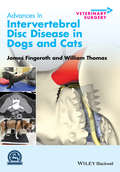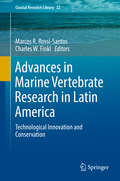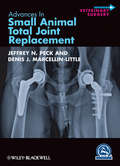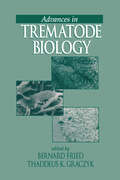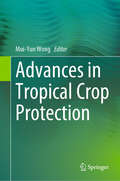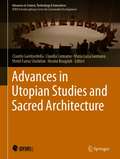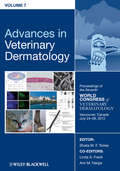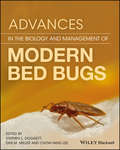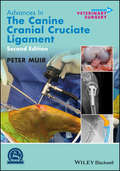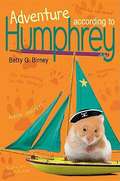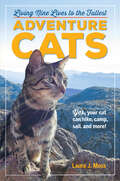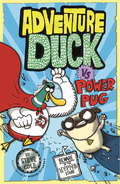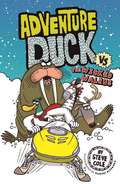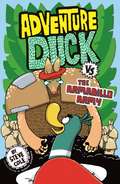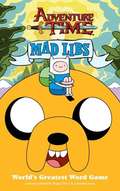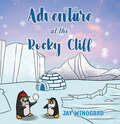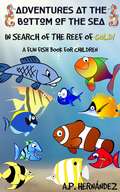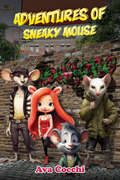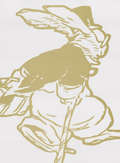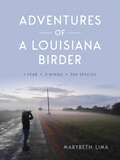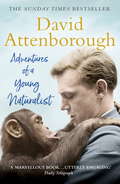- Table View
- List View
Advances in Intervertebral Disc Disease in Dogs and Cats
by James Fingeroth William ThomasAdvances in Intervertebral Disc Disease in Dogs and Cats defines our present knowledge of this common clinical problem, compiling information related to the canine and feline intervertebral disc into a single resource. As a comprehensive, focused work, the book is an authoritative reference for understanding and treating disc disease, providing a sound scientific and clinical basis for decision making. Offering an objective synthesis of the current literature, the book supplies guidance on the approach to a potential disc rupture, surgical and medical strategies, and management of the patient.Offering a complete understanding of intervertebral disc disease, the book describes and discusses the controversies and issues surrounding this topic, acknowledging the gaps in our knowledge. Advances in Intervertebral Disc Disease in Dogs and Cats presents up-to-date, reliable information on this common condition for veterinary surgeons, neurologists, and general practitioners.
Advances in Marine Vertebrate Research in Latin America: Technological Innovation and Conservation (Coastal Research Library #22)
by Charles W. Finkl Marcos R. Rossi-SantosThis book gathers the most recent research findings on ecology and conservation of marine vertebrates in Latin America, making use of high technological methods to show readers the diversity of the marine research that has been conducted in these countries over the last decades. The book brings authors from more than 23 institutions of 7 different countries developing the most diverse research aiming at ocean conservation through the ecology of different vertebrate animals, such as whales, dolphins, manatees, turtles, seabirds and fish. This book deals with technological advances and innovation in the ecology and conservation of marine vertebrates in Latin America. This eclectic collection is broad in scope but provides detailed summaries of new methods that are deployed in the study of marine environmental conservation. Key issues revolve around the development and application of educational methodologies in the field of marine vertebrate research, which provide a rational basis for better management of marine environments using modern techniques associated with GIS, satellite tracking, aerial systems, bioacoustics, biogeochemistry, genetics, underwater videography, species photoidentification, molecular biology, trophic ecological methods, ethological methods, and behavioural ecology, among others. Discussion and elucidation of these kinds of techniques are aimed at university-level students and post-graduate researchers. The scope of this volume includes whales, sharks, rays, dolphins, tropical fishes, turtles, manatees as well as aspects of Latin American marine ecosystem conservation. Researchers in this biogeographic region, as well as others involved with marine vertebrate research, will find this work essential reading.
Advances in Small Animal Total Joint Replacement
by Denis J. Marcellin-Little Jeffrey N. PeckAdvances in Small Animal Total Joint Replacement provides an up-to-date, comprehensive examination of joint replacement in veterinary surgery. Part of the Advances in Veterinary Surgery series copublished with the ACVS Foundation, the book presents an evidence-based, multi-system examination of the current state of hip, knee, and elbow replacement in dogs and cats, including information on biomechanics and biomaterials not found in other sources. Written by an international group of experts, the book offers guidance on the history, indications, contraindications, clinical procedures, and a review of the current literature for these surgical techniques.Focusing on replacement of the hip, knee, and elbow, the book also covers disc, shoulder, carpus, and tarsus replacement, as well as information on the development of custom prostheses. Each section incorporates information on potential complications and outcomes assessment. Advances in Small Animal Total Joint Replacement is an unparalleled repository of information for veterinary surgeons, residents, and practitioners with an interest in these procedures.
Advances in Trematode Biology
by Bernard Fried Thaddeus K. GraczykTrematodology - the study of a class of medically important parasitic, flat-bodied worms - has made significant advances over the past ten years. The tremendous amount of information accumulated from research discoveries and technical developments related to trematode biology makes this book a timely and necessary part of the literature. Advances in Trematode Biology presents a thorough treatment of modern trematodology, including principles and practices. With coverage of background material as well as modern methods, Advances in Trematode Biology updates researchers, practitioners, and students with new information in immunology, biochemistry, physiology, and molecular biology. Advances in Trematode Biology includes practical information on parasitological techniques, emphasizing species of medical and veterinary importance - a key reference for parasitologists, biologists, medical, and veterinary personnel. The excellent presentation of material, including well-organized tables and chapters, make Advances in Trematode Biology easy to use both as a textbook and as a reference.
Advances in Tropical Crop Protection
by Mui-Yun WongThis book presents research findings on newly discovered pests and diseases that may be impacted by climate change in the tropics; current management techniques including molecular diagnostics, integrated pest management (IPM), and agroecological approach; and recent technological advancements used as preventive and curative approaches to mitigate the effects of plant pests and diseases. Combining the expertise of leading researchers in the various fields, the book provides a useful reference for all relevant stakeholders. The proposed book is prepared with the aim of disseminating the current research development of emerging pests and diseases in the tropics in the era of climate change as well as new and eco-friendly pest and disease management technologies of tropical crops. The book is divided into three parts with sixteen chapters. Part 1: Advances in Tropical Insect Pest Management consists of five chapters describing the discovery, formulations, and applications of nature-based solutions such as natural enemies of insects, insect hormones, botanicals, and microorganisms for sustainable pest management. Part 2: Advances in Tropical Plant Disease Management consists of seven chapters, describing the causal agents of economically important diseases of tropical crops, rapid pathogen detection systems as well as effective and sustainable disease management strategies. Part 3: Advances in Other Tropical Pests Management consists of four chapters detailing the various eco-friendly pest management of vertebrates, mollusks, weeds, and emerging IR4.0 technologies in pest management. Ideas for future volumes on this subject: Volume II would be a follow-up to Volume I. It covers emerging pests and diseases of the tropics in greater depth, with a focus on specific hosts and diseases. Robust pests and disease management technologies utilized in crop protection in tropical areas by the farmers will be discussed as well.
Advances in Utopian Studies and Sacred Architecture (Advances in Science, Technology & Innovation)
by Hocine Bougdah Claudio Gambardella Claudia Cennamo Maria Luisa Germanà Mohd Fairuz ShahidanAt a time dominated by the disappearance of Future, as claimed by the French anthropologist Marc Augé, Utopia and Religion seem to be two different ways of giving back an inner horizon to mankind. Therefore this book, on the one hand, considers the importance of utopia as a tool and how it offers an economic and social resource to improve cities’ wealth, future and livability. On the other, it explores the impact of religious and cultural ideals on cities that have recently emerged in this context. Based on numerous observations, the book examines the intellectual legacy of utopian theory and practices across various academic disciplines. It also presents discussions, theories, and case studies addressing a range of issues and topics related to utopia.
Advances in Veterinary Dermatology, Proceedings of the Seventh World Congress of Veterinary Dermatology, Vancouver, Canada, July 24-28, 2012
by Sheila M. Torres Linda Frank Ann HargisRepresenting the state of the art of veterinary dermatology around the globe, Advances in Veterinary Dermatology, Volume 7, presents selected scientific papers from the Seventh World Congress of Veterinary Dermatology. The Congress, held in Vancouver, Canada in July 2012, was organized with the support of the World Association for Veterinary Dermatology (WAVD) and its affiliated societies. A record number of delegates attended from over 50 countries to take advantage of the exceptional scientific program. Cutting edge information was presented as review papers and original studies in the areas of:AllergyImmunology Skin Biology TherapyInfectious DiseasesOncologyThese peer-reviewed and edited papers were published in the journal Veterinary Dermatology in volume 24, issue 1, and are included in this hardbound book volume of the conference proceedings. Also included are 13 Workshop Reports which summarise sessions where experts presented topics in various areas providing a wonderful opportunity for colleagues to ask questions and exchange ideas in an informal atmosphere.A vital resource for all practising veterinarians and researchers interested in the field of veterinary dermatology.
Advances in the Biology and Management of Modern Bed Bugs
by Stephen L. Doggett Dini M. Miller Chow-Yang LeeThe first comprehensive scholarly treatment of bed bugs since 1966 This book updates and expands on existing material on bed bugs with an emphasis on the worldwide resurgence of both the common bed bug, Cimex lectularius L., and the tropical bed bug, Cimex hemipterus (F.). It incorporates extensive new data from a wide range of basic and applied research, as well as the recently observed medical, legal, and regulatory impacts of bed bugs. Advances in the Biology and Management of Modern Bed Bugs offers new information on the basic science and advice on using applied management strategies and bed bug bioassay techniques. It also presents cutting-edge information on the major impacts that bed bugs have had on the medical, legal, housing and hotel industries across the world, as well as their impacts on public health. Advances in the Biology and Management of Modern Bed Bugs offers chapters that cover the history of bed bugs; their global resurgence; their impact on society; their basic biology; how to manage them; the future of these pests; and more. Provides up-to-date information for the professional pest manager on bed bug biology and management Features contributions from 60 highly experienced and widely recognized experts, with 48 unique chapters A one-stop-source that includes historic, technical, and practical information Serves as a reference book for academic researchers and students alike Advances in the Biology and Management of Modern Bed Bugs is an essential reference for anyone who is impacted by bed bugs or engaged in managing bed bugs, be it in an academic, basic or applied scientific setting, or in a public outreach, or pest management role, worldwide.
Advances in the Canine Cranial Cruciate Ligament
by Peter MuirAdvances in the Canine Cranial Cruciate Ligament, Second Edition presents in-depth, focused, and updated coverage of current knowledge on cruciate ligament rupture, using a multidisciplinary, evidence-based approach. Presents a state-of-the-art summary of the most recent knowledge on this important cause of lameness in dogs Led by a highly respected surgeon and researcher, with chapters written by leading experts in the field Provides an update to the groundbreaking first edition, with six new chapters
Adventure Cats: Living Nine Lives to the Fullest
by Laura J. MossJust when you thought you knew all there was to know about cats comes the ultimate—and unexpected—guide to taking your cat into the wild. Here are cats walking on a leash. Cats hiking on a leash. Cats tramping through snow. Cats camping. Cats kayaking, canoeing, even surfing—yes, cats who love water. When animal writer and active hiker Laura Moss couldn’t find an online resource for hitting the trail with her cat, she created one. AdventureCats.org took off like wildfire, with attention from Wired, the Huffington Post, Outside magazine, BuzzFeed, and much more. Now, the book Adventure Cats—a collection of jaw-dropping photographs, inspiring stories of real-life cats, and all the how-to a cat owner needs—will take readers and their cats well beyond the backyard. Learn how to leash-train a cat. What to do if you encounter wildlife on the trail. Plus, winter safety tips, and how to bring a little bit of the outdoors to an indoor cat. The stories themselves are catnip for animal lovers, from Nanakuli, the one-eyed cat who hangs ten; to Georgie, a four-year-old gray tabby who lives on a sailboat; to Quandary, who not only insists on hiking with her family but also teaches them a valuable lesson: When you follow your cat’s natural tendency to wander, you experience the outdoors at a slower, richer pace. This book will delight every cat person, regardless of whether their pet is inclined to adventure. (Take the quiz at the beginning of the book to find out!)
Adventure Duck vs Power Pug: Book 1 (Adventure Duck)
by Steve ColeThere's no ducking out - it's time for this ordinary, wise-quacking duck to become . . . A Hero!Adventure Duck didn't ask for greatness. All he wanted was his nest on the duckpond and plenty of soggy bread to eat. But when a meteor gives him superpowers, he knows he must fly into battle and defeat the forces of evil.Every superhero needs a nemesis, and Adventure Duck finds a pint-sized one in Power Pug. This tiny arch-villain is plotting to take over the world with his hypnotic stare and an army of hench-animals. Luckily, Adventure Duck has helpers, too. There's Yoki - a mystical, moustachioed egg - and Neon Zebra, Adventure Duck's karate-kicking sidekick.Can Adventure Duck and his friends stop Power Pug in this egg-ceptionally funny, action-packed adventure?
Adventure Duck vs The Wicked Walrus: Book 3 (Adventure Duck)
by Steve ColeThere's no ducking out - the space race is on and Adventure Duck must defeat his new nemesis, the Wicked Walrus!Adventure Duck fluffs up his feathers and heads to the North Pole, where his ice-hearted enemy, Power Pug, has set up a secret space base. The pug's latest hench-animal, a super-smart walrus, is building a rocket to blast his master to Mars. But if it launches, the whole Artic will be wiped out! Can Adventure Duck and his new friend - an (occasionally) invisible reindeer - stop Power Pug from expanding his evil empire in outer space?
Adventure Duck vs the Armadillo Army: Book 2 (Adventure Duck)
by Steve ColeThe duck with the supersonic quack is back! Adventure Duck, the world's unlikeliest superhero, has a tasty new mission - saving the world from DEATH BY CHOCOLATE!Ay, caramba! Adventure Duck and his zebra sidekick, Ziggy, have a tasty new mission in Mexico. Their nemesis, Power Pug, has a dastardly new scheme to control the world's chocolate supply. With the help of a llama with projectile spit, Adventure Duck and Ziggy set out to foil the pug's nefarious plans to dig up the rainforest to build an enormous chocolate factory. But Armando the Commando and his army of armadillos stands in their way... Can the superhero amigos find a chink in the armadillos' armour and save the world from DEATH BY CHOCOLATE?
Adventure Stories
by BPI India Pvt Ltd"Adventure Stories" is collection of short stories, The book is design to reading out to kids or encouraging them to read stories and develop children's oral skills.
Adventure Time Mad Libs
by Roger Price Leonard SternFill in the blanks with Finn and Jake! Adventure Time Mad Libs is based on the popular Cartoon Network show starring Finn, a silly kid with an awesome hat, and his dog Jake! Our book features 21 hilarious stories set in the mystical Land of Ooo that are sure to keep you laughing!
Adventure at the Rocky Cliff
by Jay WinogradClutch and Haiven were two young penguins who lived in Penguin Land way down near the South Pole. Clutch was playful, brave and adventurous. He often imagined that he was a brave warrior penguin. Haiven was serious, careful and cautious, and enjoyed studying and playing the violin. Even though they were very different, they were still best friends, and often hung out together. They always did their best to remember the three rules of life: work hard, be kind to others, and be on time. One day, Clutch and Haiven decided to go to the Rocky Cliff. While Clutch would jump and dive into the water, Haiven would give him scores as if it were the Penguin Olympics. For a while, both penguins were having lots of fun. All of a sudden, Haiven found himself in very serious danger. Nobody, not even Clutch, could help him get out of the danger he was in. He had to learn to be brave very quickly.
Adventure on Dolphin Island
by Ellen PragerA family vacation aboard a rented sailboat turns into a horrible nightmare when young Kelly Wickmer is swept off the boat in a raging storm in the Bermuda Triangle. Alone in the wild sea, the timid young girl must struggle for survival and fight her fears of the ocean and its creatures, especially sharks. As darkness surrounds her, a nearby wave explodes in shimmering light and a dolphin appears. The dolphin brings Kelly to a mysterious tropical island, unlike anything she has ever seen or heard about. Kids on the island befriend her as they encounter stingrays, sea turtles, iguanas, giant tortoise, the fish of a coral reef, and more. Yet, Kelly longs to go home. As she searches for a way off the island and the dolphin that saved her, she will have the adventure of a lifetime. If she survives, it will change her life forever. Adventure on Dolphin Island combines the best of fiction and non-fiction, with an exciting story of fantasy and adventure blended with fascinating true details about the sea and marine life. A percentage of the profits from sales will go toward marine education.
AdventureCat Goes to School
by Susan Clymer[from the back cover] "Who sits high up on the classroom flagpole? Who leaves a mouse's head on the teacher's chair? Who curls up inside a desk and goes to sleep? Who gobbles chicken in the cafeteria? AdventureCat tells the story of her first visit to school. What a story! What a cat!" AdventureCat is brave, curious and outspoken. She even calls the teacher names! Contains frequent use of spelling changed to resemble the accent a cat would have if it could speak such as: freeeee, lifffffee, rowling, Meeeooowwwser, dogsss, cat-lamity and booooyyyy.
Adventures among Ants: A Global Safari with a Cast of Trillions
by Mark W. MoffettIntrepid international explorer, biologist, and photographer Mark W. Moffett, "the Indiana Jones of entomology," takes us around the globe on a strange and colorful journey in search of the hidden world of ants. In tales from Nigeria, Indonesia, the Amazon, Australia, California, and elsewhere, Moffett recounts his entomological exploits and provides fascinating details on how ants live and how they dominate their ecosystems through strikingly human behaviors, yet at a different scale and a faster tempo. Moffett's spectacular close-up photographs shrink us down to size, so that we can observe ants in familiar roles; warriors, builders, big-game hunters, and slave owners. We find them creating marketplaces and assembly lines and dealing with issues we think of as uniquely human--including hygiene, recycling, and warfare. Adventures among Ants introduces some of the world's most awe-inspiring species and offers a startling new perspective on the limits of our own perception. * Ants are world-class road builders, handling traffic problems on thoroughfares that dwarf our highway systems in their complexity * Ants with the largest societies often deploy complicated military tactics * Some ants have evolved from hunter-gatherers into farmers, domesticating other insects and growing crops for food
Adventures at the bottom of the sea. In Search of the reef of gold! A Fun Fish Book for Children
by A. P. HernándezThe ocean is full of mysteries but, above all, it is full of fish. With this book you can meet the funniest! Alex is a clown fish. Angel is an angel fish (doesn't his name fit him like a glove?). And Aya is a manta ray. And together they go in search of... the reef of gold! Explore the ocean with them, live great adventures and meet many other friends: a moray eel, a parrot fish that speaks more than a parrot and a singing barracuda. Immerse yourself in your reading! A fun children's fish book that includes numerous photographs. Ideal for getting to know the facts and curiosities of some of the fish from the Indo-Pacific Ocean.
Adventures of Sneaky Mouse
by Ava CocchiThis story takes place outside your window, as you walk your dog, your postman delivers your mail, your friends ride their bikes past your house. If you look super close, I mean with super-duper binoculars, you will find a tiny, brave mouse sneaking around your neighborhood to protect his friends and family in their villages.His name is Luca, but everyone calls him Sneaky Mouse. Sneaky Mouse loves cheese! All kinds of cheese: blue, mozzarella, cheddar, goat, but not American – American cheese is not cheese in mouse-houses! Originally Sneaky Mouse and his friends, Ciara, Rocco, and Julian, would sneak into your homes to find leftover cheese to fill their bellies, but one day Sneaky Mouse realized he was needed in his village called Mouse Wood for more than just cheese. He realized he could save lives.Of course, like all superheroes, Sneaky realized he can&’t save everyone, and that gave him a lot of anxiety. Read how the neighborhood mouse becomes a hero amongst his fellow mice and overcomes his own fears and anxiety.
Adventures of Uncle Wiggily: Adventures Of The Rabbit Gentleman With The Mother (Dover Children's Classics)
by Howard Garis Louis WisaGenerations of children and adults have thrilled to the adventures of Uncle Wiggily Longears, the gentleman rabbit. These heartwarming tales from a century ago recount Uncle Wiggily's devotion to helping children and animals--and himself--out of perilous scrapes. The wise old rabbit saves the day, using a combination of wit, sincerity, positive thinking, and other timeless virtues.This beautiful keepsake edition features 19 of Uncle Wiggily's most popular exploits, all accompanied by vivid colorful versions of the original illustrations. The two-color images have been given new life with wonderfully vibrant tones that add to the fun of Uncle Wiggily's adventures. Join the old gentleman rabbit's family circle--including Sammie and Susie Littletail, the bunny children; the puppies Jackie and Peetie Bow-Wow; and Billie and Johnnie Bushytail, the squirrel boys--for fun in their forest home. And when Dr. Possum advises Uncle Wiggily to travel, you, too, can come along to discover other fields and forests and meet new friends.
Adventures of a Louisiana Birder: One Year, Two Wings, Three Hundred Species
by Marybeth LimaThis candid and humorous chronicle shows how one woman goes from casual observer to obsessive bird nerd as she traverses Louisiana’s avian paradise. In Adventures of a Louisiana Birder, readers follow Marybeth Lima across her adopted state in search of 300 species of birds. Bisected by the Mississippi flyway and home to 400 miles of coast, Louisiana has a variety of habitats, which serve as a beautiful backdrop to this remarkable journey. In birding circles, some devotees attempt what is known as a “big year,” a bird-sighting challenge to identify as many bird species as possible in a particular geographical area over the course of one year. Lima’s initial effort amounted to 11,626 miles in sixty-one road trips to log an impressive 280 species. But on a subsequent quest to exceed her record, she endures elusive birds, embarrassing misidentifications, and hungry insects in an effort to reach her goal. In the midst of these obstacles, Lima celebrates the camaraderie and friendly competition among fellow birders, from novices to a world-renown ornithologist. Requiring both mental focus and physical agility, birdwatching becomes an active sport through Lima’s narration. She vividly conveys the elation over a rare species seen or heard and the disappointment when one is narrowly missed. An appendix provides the location and date of every species she identifies. Lima’s personal experiences are interwoven with the excitement of tracking down one intriguing species after another. She faces a near-fatal burn accident to her spouse, end-of-life care for her mother-in-law, and Louisiana’s great flood of 2016. In the midst of these situations, her devotion to birding provides a much-needed outlet. “Somewhere in the roiling confluence of birds, locales, and human personalities,” writes Lima, “the center of my heart sings with utter abandon.” Adventures of a Louisiana Birder is the author’s call to a deeper passion for and awareness of Louisiana’s unique natural beauty and vulnerability.
Adventures of a Young Naturalist: SIR DAVID ATTENBOROUGH'S ZOO QUEST EXPEDITIONS
by Sir David AttenboroughTHE SUNDAY TIMES BESTSELLER'A great book for anyone who wants to vicariously travel like an old-fashioned adventurer and seeks to understand how far we have come in developing a protective attitude to wildlife' New York Times'A marvellous book ... unputdownable ... utterly engaging' TelegraphIn 1954, a young television presenter named David Attenborough was offered the opportunity of a lifetime - to travel the world finding rare and elusive animals for London Zoo's collection, and to film the expeditions for the BBC. Now 'the greatest living advocate of the global ecosystem' this is the story of the voyages that started it all. Staying with local tribes while trekking in search of giant anteaters in Guyana, Komodo dragons in Indonesia and armadillos in Paraguay, he and the rest of the team battled with cannibal fish, aggressive tree porcupines and escape-artist wild pigs, as well as treacherous terrain and unpredictable weather, to record the incredible beauty and biodiversity of these regions. The methods may be outdated now, but the fascination and respect for the wildlife, the people and the environment - and the importance of protecting these wild places - is not.Written with his trademark wit and charm, Adventures of a Young Naturalist is not just the story of a remarkable adventure, but of the man who made us fall in love with the natural world, and who is still doing so today.
